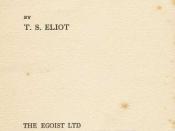Prufrock is portrayed as a shy and timid character whose thoughts and attitudes are severely degraded by failure and low self esteem. He is self-conscious and indecisive, unwilling to take any risks, out of the fear of rejection. The poem contemplates his unsuccessful attempts to win over women and fit in with society. This is largely due to his pessimistic and self-critical nature, melancholy attitude and suppression. As a consequence of his self-doubting temperament, he forms feelings of isolation and loneliness, manifesting an anti-hero status.
Prufrock's identity is chiefly explored by three stylistic features. These are the use of an epigraph, recurring images and repetition.
The epigraph explores the suffering and uncertainty in Prufrock's identity in an effective way. It is in first person and therefore provides insight about what Prufrock is thinking. The metaphor 'this flame' alerts the reader that Prufrock has some sort of desire or unresolved issues which torment him.
Phrases such as 'none ever did return alive from this depth' indicate that Prufrock is calling out from the depths of hell with a sense of pessimism and depression. A key stylistic feature used in the epigraph is juxtaposition. The title 'Love Song' implies the poem will be about a man's compassion and love for his wife or girlfriend, yet the introductory epigraph contrasts this theme entirely, rather creating the mood of a tormented, suffering man experiencing hell. This contrast helps to convey Prufrock's true identity to the reader.
Recurring images are another key stylistic feature used to explore Prufrock's identity. The reference to the image of 'oyster-shells' is evidence of his suppressed self, and along with the metaphor of 'yellow fog', form the recurring imagery of the sea. The latter metaphor portrays the fog with cat-like qualities, such as 'rubbing its...


